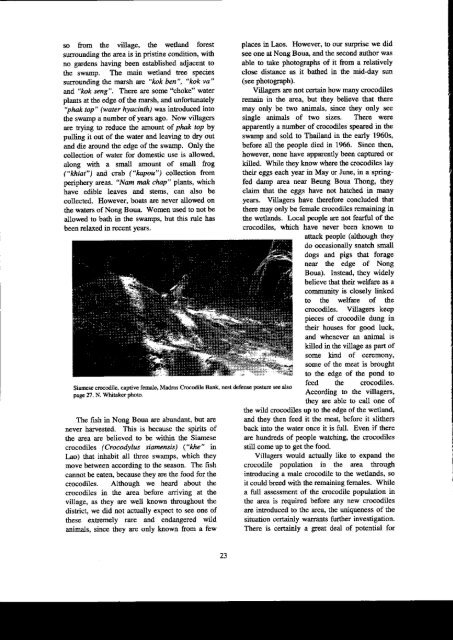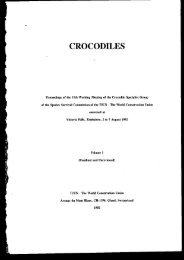NEWSLETTER - Crocodile Specialist Group
NEWSLETTER - Crocodile Specialist Group
NEWSLETTER - Crocodile Specialist Group
You also want an ePaper? Increase the reach of your titles
YUMPU automatically turns print PDFs into web optimized ePapers that Google loves.
so from the village, the wetland forest<br />
sunounding the area is in pristhe condition, with<br />
no gardens having been established adjacent to<br />
the swanp. Ttre main weuand tree species<br />
surrounding the marsh ue "kok ben", "kok va"<br />
and "kak seng". Therc are some "choke" water<br />
plants at the edge of the marsh, and unfortunately<br />
"phak top" (water hyacintlr) was introduced into<br />
the swamp a number of years ago. Now villagers<br />
are trying to reduce the amount of phok top by<br />
pulling it out of the water ard leaving to dry out<br />
alrd die around the edge of the swamp. Only the<br />
collection of water for domestic use is allowed,<br />
along with a small amoutrt of small frog<br />
("khiat") ad crab ("lctpou" ) collection fiom<br />
periphery arcas. "Ncm nak chap" plants, which<br />
have edible leaves and stems, can also be<br />
collected. However, boats are never allowed on<br />
the waters of Nong Boua. Women used to not be<br />
allowed to bath in the swa$ps, but this nrLe has<br />
been daxed il recent vears.<br />
Siafi€s€ crocodile, captive femalie, Madras <strong>Crocodile</strong> BaJIk, nest defeDse p6ture see also<br />
paBe 27, N whitaker photo.<br />
The frsh in Nong Boua arc abundant, but are<br />
never harvested. This is because the spirits of<br />
tlle area are believed to be within the Siamese<br />
crocodiles (Crocodylus siamensis) ('kh.e" n<br />
Lao) that inhabit all three swamps, which they<br />
move between according to the season. Tte fish<br />
cannot be eaten" because they are the food for the<br />
crocodiles. Although we heard about the<br />
crocodiles in the area before arriving at the<br />
village, as they are well knoqn throughout the<br />
distric! we did not actually expect to see one of<br />
these extremely rare and endangered wild<br />
animals, since they are only knolvn ftom a few<br />
places in Laos, However, to our surprise we did<br />
see one at Nong Boua, ald the second author was<br />
able to take photographs of it ftom a relatively<br />
close dista.nce as it bathed in the mid-day sun<br />
(see photograph).<br />
Villagen are not certain how many crocodiles<br />
remain in the ares, but they believe that there<br />
rnay only be two animals, since they only see<br />
single animals of two sizes. Therc were<br />
apparendy a number of crocodiles speared in the<br />
swamp and sold to Thailand ir the early 1960s,<br />
before all the people died in 1966. Since then,<br />
however, none have apparently been captured or<br />
killed. While they know where the crocodiles lay<br />
their eggs each year in May or June, in a springfed<br />
damp area near Beung Boua Thong, tley<br />
claim that the eggs have not hatched in many<br />
years. Villagers have therefore concluded that<br />
there may only be fernale crocodiles remaidng in<br />
tle wedands. I-ocal people are not fearful of the<br />
crocodiles, which have never been known to<br />
attack people (although they<br />
do occasionally snatch small<br />
dogs a.nd pigs that forage<br />
near the edge of Nong<br />
Boua). Instead, they widely<br />
believe that their welfare as a<br />
community is closely linked<br />
to the welfare of the<br />
crocodiles. Villagers keep<br />
pie€es of crocodile dung in<br />
their houses for good luck,<br />
and whenever an animal is<br />
killed in the village as part of<br />
some kind of ceremony,<br />
some of the meat is brought<br />
to the edge of the pond to<br />
feed the crocodiles.<br />
According to the Yillagers,<br />
they are able to ca.ll one of<br />
the wild qocodiles up to the edge of the wedand,<br />
and they then feed it the meat, before it slithers<br />
back into the water once it is firll. Even if there<br />
are hundreds of people watching, the crocodiles<br />
still come up to get the food.<br />
Villagers would actually like to expand the<br />
crocodile population in the area through<br />
htroduci[g a male crocodile to the wedands, so<br />
it could breed with the remaining females. Wlile<br />
a flrll assessment of the crocodile population in<br />
the area is required before any new crocodiles<br />
are introduced to the area, the uniqueness of the<br />
situation certainly wanants further investigation.<br />
There is certafu y a great deal of potential for

















